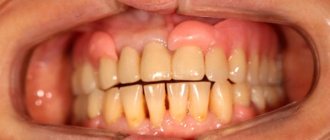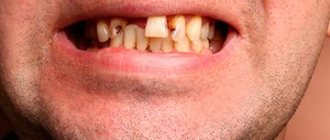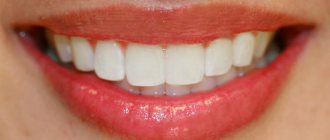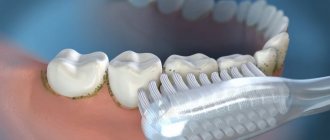According to statistics, 98% of people are afraid of visits to the dentist. As a result, solutions to dental problems are postponed until the last minute, until one day we discover that the tooth has rotted. Then a visit to the doctor is inevitable, but a lot of work remains.
Contrary to popular belief, rotten teeth are not only a result of poor hygiene.
Causes of tooth decay
Yes, we all know that you need to brush your teeth 2 times a day, be sure to use dental floss and visit the dentist 2 times a year. Many patients follow these recommendations, but their teeth still deteriorate and rot. Poor hygiene is not the only reason why teeth deteriorate. There are other factors:
- Gum diseases
provoke the proliferation of bacteria, which literally gnaw through the enamel and destroy tooth tissue; - genetics
plays a role in the ability of teeth to resist pathogenic factors; - an unfavorable ecological environment
leads to the fact that in industrial areas there are more dental problems than in places where there are no factories; - Water quality
directly affects teeth. Low content of useful minerals (fluorine, calcium), high content of heavy metal salts can destroy teeth, despite hygiene; - bad habits
. Smokers have worse teeth than non-smokers and treatment is more difficult; - general diseases
, for example, problems with the gastrointestinal tract, negatively affect the condition of the teeth; - carbohydrates
in the diet , as well as hard food products that injure the gums and enamel lead to tooth decay.
To understand why teeth rot, you need to undergo an examination. Don’t be surprised if the doctor asks you to take tests or do an ultrasound. Dental treatment requires a comprehensive approach and diagnosis is more important than ever. Having found out why teeth are rotting, the doctor will prescribe adequate treatment.
How does a tooth rot?
Recognizing that dental tissue is susceptible to rotting is not so difficult. There are a number of pronounced symptoms that indicate this:
- A bad odor appears from the mouth.
- The color of the tooth does not change for the better; it begins to darken.
- Holes appear on the tooth. When food, cold or hot liquids get into them, acute, sometimes unbearable pain is observed.
- In the most advanced cases, loosening of the unit is observed.
If you experience at least one of the above signs, you need to urgently go to the dentist, otherwise you may lose a tooth. Remember that having a rotten tooth is not only an aesthetic drawback. This can lead to other health problems.
Stages
Caries, like a secret agent, begins to act on the sly and may not make itself felt for years. Its initial stage is called the “white spot stage.” Well, how can you see white on white? That is why it is important to visit the dentist regularly - the specialist will highlight the white spot against the background of the enamel and cure caries in time. And if you start it, the disease goes to the next level:
- Surface.
The enamel is still intact, but in the area of the stain it becomes rough. The stain deepens. The tooth begins to react to cold and hot. - Average.
Caries penetrates to the dentin, but it does not provide access to the pulp. A damaged tooth reacts to temperature, mechanical, and chemical stimuli. But the pain is not constant, it goes away quickly. - Deep.
The pain is sharp when touched, but gradually subsides. A carious cavity is visible to the naked eye.
Causes of periodontitis
One of the causes of elevated body temperature may be periodontitis. This is a complex disease that occurs as a complication against the background of processes such as caries and pulpitis. In such cases, inflammation affects not only the tooth itself, but also nearby tissues. The development of this process is preceded by prolonged pain caused by bacterial damage to the tooth tissue.
Periodontitis is one of the causes of fever
Symptoms of periodontitis include fever and toothache. The pain is constant, acute, does not decrease when taking analgesics and intensifies with any load on the diseased tooth. In addition to these, the following symptoms are observed:
- swelling of the gums adjacent to the diseased tooth;
- swelling of the cheek on one side;
- enlarged and painful submandibular lymph nodes;
- sensation of changing the size of the diseased tooth.
Periodontitis therapy
As a rule, in case of periodontitis, it is recommended to remove a damaged tooth. The possibility of its preservation is considered in each case individually and depends on the nature of the damage and the severity of the disease. As a therapy for periodontitis, anti-inflammatory drugs with calcium hydroxide are used, which are placed in previously sanitized dental canals. This treatment takes a long time due to the fact that the drug acts slowly.
Important ! If the process is complicated by the presence of a cyst on the tooth, the apex of the root or the entire tooth is removed.
If the disease is severe, the tooth may be removed
Why do children's teeth rot?
In children, the composition of saliva is not the same as in adults. Its antibacterial properties are low; in a warm, humid environment, microbes multiply quickly. The disease is not only common, it progresses rapidly. Caries spreads in width and depth. Single events are rare; usually several teeth are affected at once. For children, timely identification and treatment of problem teeth is of particular importance. Rotten teeth can cause:
- pulpitis and periodontitis;
- malocclusion;
- loss of milk and permanent teeth;
- inflammation of the maxillofacial apparatus.
Bad teeth affect the social adaptation of children and lead to psychological problems.
Prevention includes hygiene procedures, limiting sweets, a balanced diet and regular dental examinations.
Why is this happening?
The main reason for this problem is poor hygiene, lack of timely dental treatment and neglect of preventive dental examinations. In 90% of cases, it is these factors that cause tooth decay. There are also indirect reasons that can affect this process:
- Having bad habits, especially smoking.
- Hereditary predisposition.
- Bad ecology.
- Poor nutrition.
- Concomitant diseases of the oral cavity.
- Poor quality drinking water.
Teeth and pregnancy
We found out why children's teeth rot. There is another group of people particularly at risk of tooth decay. These are pregnant women. Some scientists classify pregnancy as an immunodeficiency state - the body's resistance to pathogens decreases to such an extent. It’s no wonder that during pregnancy, general diseases worsen and dental problems begin. The increased content of hormones in the body reduces the barrier ability of the epithelium, microorganisms more easily penetrate the gums and begin to multiply.
Help protect your teeth:
- rational and balanced diet;
- multivitamin complexes;
- professional oral hygiene;
- herbal baths;
- applications with calcium and phosphates.
Recovery after treatment
After opening and draining the cavity, the body has to mobilize all its resources to speed up the healing process. To help him, it is important:
- comply with all medical prescriptions;
- take medications prescribed by the dentist;
- Healthy food;
- avoid stressful situations;
- dress according to the weather;
- quit smoking and alcohol;
- take a good vitamin and mineral complex;
- carefully monitor oral hygiene, include dental rinse, floss, and irrigator in your daily care.
What to do if a tooth is rotten
Until recently, the only solution to the problem was deletion. Today, dental science offers various methods and techniques for restoring teeth.
The method of influence depends on the specific case. What matters is the depth of the lesion, its area, the stage of the disease and the degree of destruction.
Treatment at the initial stage
At the stain stage, you can do without a drill, because it is this that frightens you the most and makes you put off visiting a doctor.
Apply:
- Ozone therapy
. Ozone treatment destroys bacteria, and special preparations restore enamel. - The laser
also destroys bacteria, without heating the tissue and serves as a good preventive measure for gum disease. - Infiltration treatment
.
The chemical composition destroys bacteria, and the infiltration material “seals” the enamel pores and prevents pathogens from penetrating inside.
Treatment for moderate and severe stages
If the disease is advanced, the dentist will still try to save the tooth. At the same time, you can no longer do without a drill. After the examination, the doctor decides how to treat the decayed tooth. But the general principles are the same: after the administration of anesthesia, all dead tissue is removed, the cavity is disinfected and a filling is placed.
If the crown of a tooth has rotted, but the root has been preserved, after treatment the tooth is prepared for prosthetics using:
- Inlays under the stump.
They replace damaged tooth tissue. Inlays are made from zirconium, ceramics, and precious metals. One part of the tab is inserted into the dental canal, and a crown is put on the other. - Pins.
A pin is a rod that is inserted into the dental canal, and a crown is installed on top. They are made of metal or fiberglass.
Modern prosthetics offer a huge variety of materials. Crowns are made from traditional materials: metals and metal-ceramics, composites, zirconium alloys, and modern metal-free compounds.
Preventive crown care
In order not to provoke the accumulation of masses under the crown and cause tooth decay, it is necessary to maintain oral hygiene. A crown is an artificial structure and will require more care.
- Brush your teeth twice a day, including using special brushes for caring for dentures.
- Rinse your mouth after every meal.
- Floss regularly.
- Use toothpicks only when necessary. This is not at all a means of maintaining dental hygiene! Picking with a wooden stick, expanding cavities in teeth and crowns, is contraindicated.
If you have already had the sad experience of tooth decay under a denture, pay more attention to the alarm bells: pain under the crown, bad smell, taste of blood in your mouth. Make an appointment with a dentist; timely treatment will be shorter and cheaper than treatment for a neglected tooth.
If you realize that the tooth has begun to rot, remember that the process is irreversible. It will not be possible to cure inflammation with home methods. You should not wait until there is severe pain or the crown falls out in your sleep, with the risk of suffocation. A diagnosis from a doctor will help you cope with the problem.
Make an appointment at Dr. Lopaeva's clinic
Make an appointment
Or call +7(985)532-21-01
Tooth hurts after nerve removal, root canal treatment
Why a tooth can rot under a crown, what needs to be done and where to go
A tooth hurts under a crown, where to go in Moscow
NuCalm – dental treatment without fear and stress, relaxation without medications
Implantation is a solution for advanced cases
Alas, if the root of a tooth has rotted, then the only solution is removal. But even here, dentists offer a method that will help restore a rotten tooth - implantation. The implant will stop bone loss, prevent loosening and tilting of neighboring teeth, and restore your smile. The immediate loading method involves placing an implant immediately after tooth extraction. There is no need to wait for the hole to heal and you can chew almost immediately.
First aid for fever and toothache
You should make an appointment with a doctor as soon as possible - any pre-medical care is aimed only at eliminating the symptoms, and only a dentist can perform the cause and correct diagnosis. The reasons can be very different - damage to dental tissue, inflammation of the gums, neuralgia and others.
- How to deal with unpleasant odors in the home of a seriously ill person
It is better to call an ambulance if the temperature rises above 39 degrees
It is especially critical to visit a doctor as quickly as possible if symptoms persist for longer than a day - the temperature may be due to the fact that the infection is in the blood, and this is fraught with serious complications. If weakness and poor health do not allow you to get to the dentist on your own, and the temperature rises above 39 degrees, it is better to call emergency help.
Treatment in dentistry
Whether a tooth can be treated depends on the severity of the carious process, so doctors first prescribe x-rays to patients. If the situation is not critical and the dentist can save the tooth from rotting, he carefully cleans it of accumulated deposits (plaque and stone) and begins treatment:
- Anesthesia is performed.
- All areas of enamel affected by the carious process are removed, and the rotting pulp must also be removed.
- The dental cavity is washed with an antiseptic.
- The integrity of the surface is restored with filling material. After the filling is installed and hardened, the patient must check the bite: if discomfort is felt, the excess layer of filling material must be removed.
Teeth that are rotting from the gums are treated in the same way, but photopolymer materials are usually used to fill them. They harden quickly, are characterized by increased strength and high aesthetics.
The dentist may prescribe an antibiotic to prevent the infection from spreading throughout the body. For severe pain, an analgesic is prescribed.
There are methods that can be used to prevent damage to dental tissues by cariogenic bacteria. Almost all dental clinics carry out remineralization - strengthening the enamel structure with special preparations. In a hospital or at home, you can perform fluoridation - saturating the enamel with fluoride.
Radical way - removal
Removal of a rotten tooth root is carried out in cases where none of the tooth-preserving techniques can be used. It will not be possible to avoid removing a rotten tooth root if you have:
- complex fractures of a dental unit;
- acute inflammation of the tissues surrounding the rotting root;
- destruction of part of the tooth crown located significantly below the gum level;
- tooth root mobility of the third degree;
- abnormal location of the affected unit.
Is it possible to cure a rotting tooth?
If a diseased tooth has not completely rotted, consulting a doctor will help save it. To understand whether it can be treated, an x-ray examination is prescribed, the results of which will determine the cause of the development of the rotting process. The method of treatment is determined taking into account the factor that provoked tooth decay.
Modern dentistry has a large number of tooth-preserving techniques, the main types of which are divided into conservative and conservative-surgical. In the first case, preservation of the destroyed unit does not require surgical intervention; root restoration is carried out using restoration, during which pin structures, inlays or coronal elements are used.
If there is inflammation at the apex of the tooth root, then a conservative surgical method of tooth preservation is used. Its resection is performed after preliminary filling of the canals. This procedure is simple, in most cases it is performed under local anesthesia and lasts no more than half an hour.
In certain situations, when the apex or base of a tooth root becomes inflamed, it is possible to do without surgical intervention. An anti-inflammatory drug is injected into the tooth canal for a period of 2-3 months to 1-2 years, which allows you to restore the bone tissue surrounding the tip of the tooth root.
Treatment of inflammatory processes of tooth roots
Let’s make a reservation right away: treatment is possible only in a highly qualified dental clinic. The pathology is serious, and therefore requires an accurate diagnosis and thoughtful treatment, which can be either conservative or surgical.
With the conservative method, the following is carried out:
- X-ray diagnostics.
- If there are old fillings, they are removed to give access to the dental canals.
- Mechanical cleaning of canal cavities and removal of nerve endings.
- Expansion and antiseptic treatment of canals (for tissue disinfection).
- Treatment by placing a medicinal mixture into the cavity and then installing a temporary filling.
Then, at a subsequent visit to the dentist, the temporary filling is removed; if the inflammation has stopped, a permanent filling is performed. In particularly difficult cases, two visits for a complete cure will not be enough, and up to several weeks or even months of therapy will be required. Upon completion of all treatment measures, a control x-ray is taken. During the healing period, antibiotics and other antibacterial drugs may be prescribed.
If the dentist sees that conservative methods of therapy will not bring the desired result or the procedures already performed have not produced a positive effect, surgical intervention is indicated. Surgical treatment of acute and chronic periodontitis involves removing the upper or slightly larger part of the root, and sometimes completely eliminating the tooth and the inflamed root.










